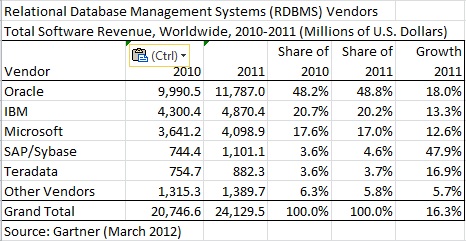Relational databases were developed in the 1970's by IBM's Edgar Codd and over the last 40 years has become the leading way of storing data. Originally data was saved in flat files which made users enter in data over and over again which led to errors in the files as humans are only so perfect. Relational databases were the answer to avoid flat files and hold more data in an era when every megabyte counted. Relational databases are ways of organizing data in ways that allow it to be easily accessed and understood by any user. Additionally relational databases allow for data to be updated by referencing other rows, columns, and tables. As shown below most of the worlds largest tech firms use RDBMS ( Relational Database Management Systems)

Relational Databases are important as they are used in almost every function regarding computers. From the operating systems that run your electronics to the games that keep your high score saved. All of them use the fundamentals of Relational databases in order to run correctly. Below is an example of how a basic relational database functions. The attributes on that form the column and the tuple that form the row together create a matrix called a relation. When this is coded it is just a string of variables but in this context you can see how the output would look. Furthermore this database is able to store information as well as reference other information in a separate location. By doing this the database can be adjusted by the updating of information at another end. A good example would be the charts at an airport. There are several rows of information that is dependent on a flight however that flight data must be stored on another sheet in the airports mainframe which is updated by the pilots in the air as to what the ETA is on their flight.

With regards to AE 510, Relational Databases are important because they are what govern all BIM programs. The walls, windows, doors, beams, columns are all kept in a database and then used in harmony whenever you want to make an edit to your building. The only way that parametric modeling works is if database relations can update another part of the model that is connected to the piece that is important to the user. Additionally when the user wants to bring up an piece of information on a part of the model the saved data is usually being pulled from a database that has multiple pieces of information about the given part. Furthermore when running analysis on the situation the different parts will all be taken into account which will allow for better modeling of structural, mechanical, and electrical loads and figures.
In the near future, Relational databases will only get more widely used. However that is not to say that a new form of storing information will not come into play. Flat Files thought they would be the only way to store data until the seventies and it only a matter of time until the next big thing occurs. In the meantime it is important to appreciate how these databases work and what they are used in. It leads to better understanding our our systems and the way they operate.
Comments:
Ryan's blog - I liked your post and the fact that you looked into the future with how databases would be used. I think the fact that databases will be used in real time is something that the field is not used to at this point in time but will definitely be something we will be using on a daily basis. Furthermore, I like your personal touch and relating it to your personal experience. It definitely brings it all back down to earth and more realistic for me.
Brian's blog - Your discussion of SEED was different. I have never worked with this program before but the fact that it saves your designs is a very nice power to have. Instead of overwriting a model you can design for all the different criteria and see which one works best. I do understand how it can be abused tho. Eventually you will think that one type of building is similiar enough to another building that you will pass the design off as already done instead of doing a unique model for the new buidling. While this is frustrating I can see it happening.
Sources:
[1] "The Theory OfRelational Databases." David Maier: The Theory of Relational Databases. N.p., n.d. Web. 11 Feb. 2014. http://web.cecs.pdx.edu/~maier/TheoryBook/TRD.html
[2] ftp://128.148.32.111/pub/techreports/89/cs89-39.pdf
[3] "A Simple Guide to Five Normal Forms in Relational Database Theory." A Simple Guide to Five Normal Forms in Relational Database Theory. N.p., n.d. Web. 11 Feb. 2014. http://www.bkent.net/Doc/simple5.htm
Thank you Matt for that very informative blog post. Do you have any ideas of what the next file storing is going to be? Do you think that the next big thing is already here with cloud databases? I like how you included photos for a more visual representation of how a database works.
ReplyDelete